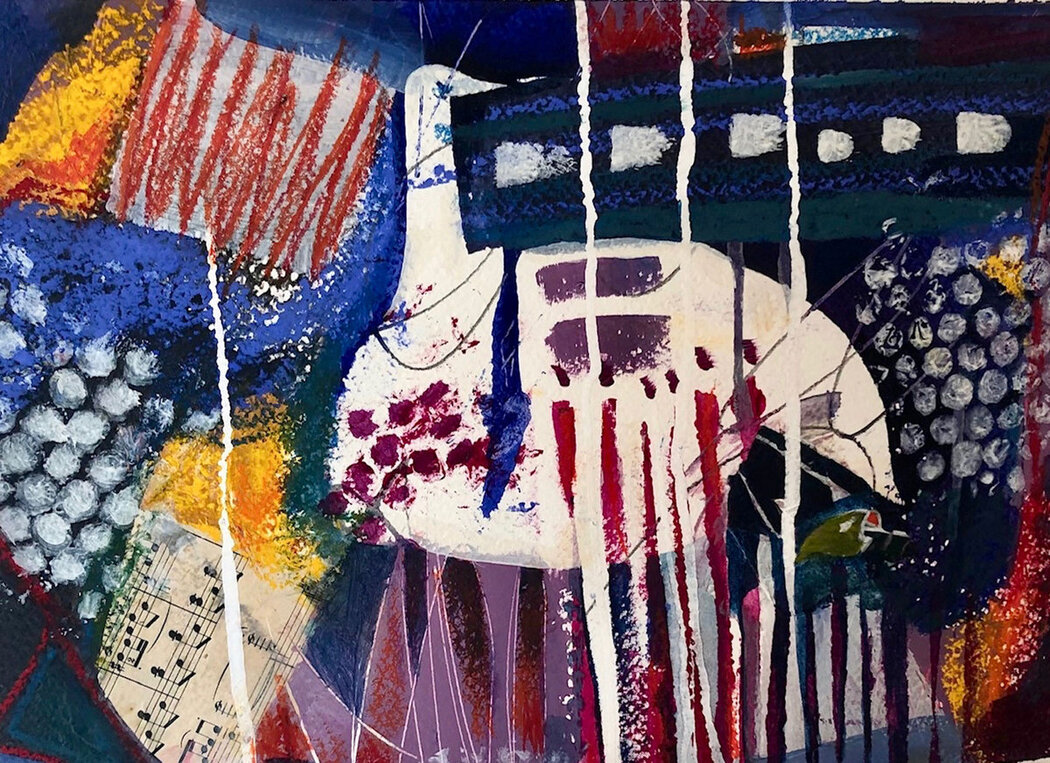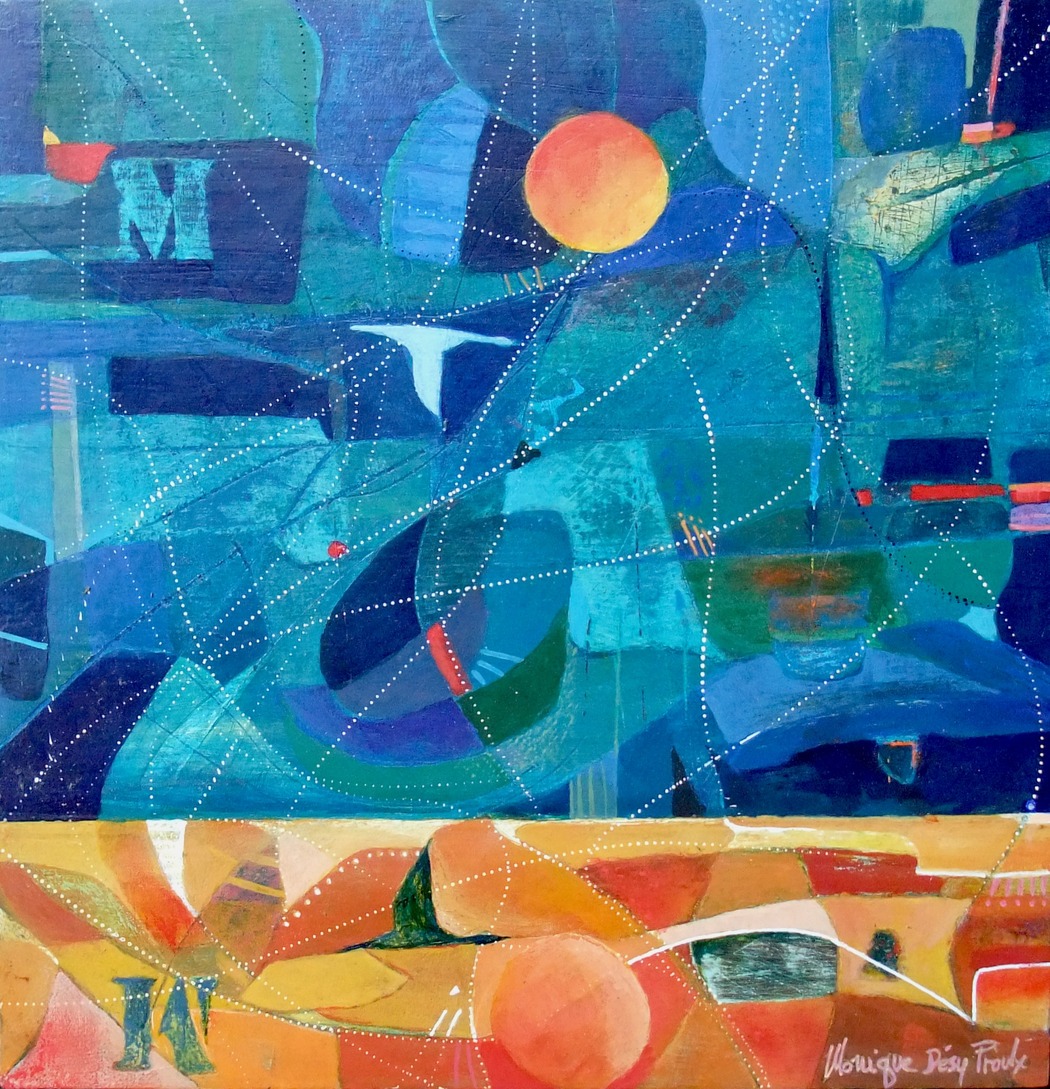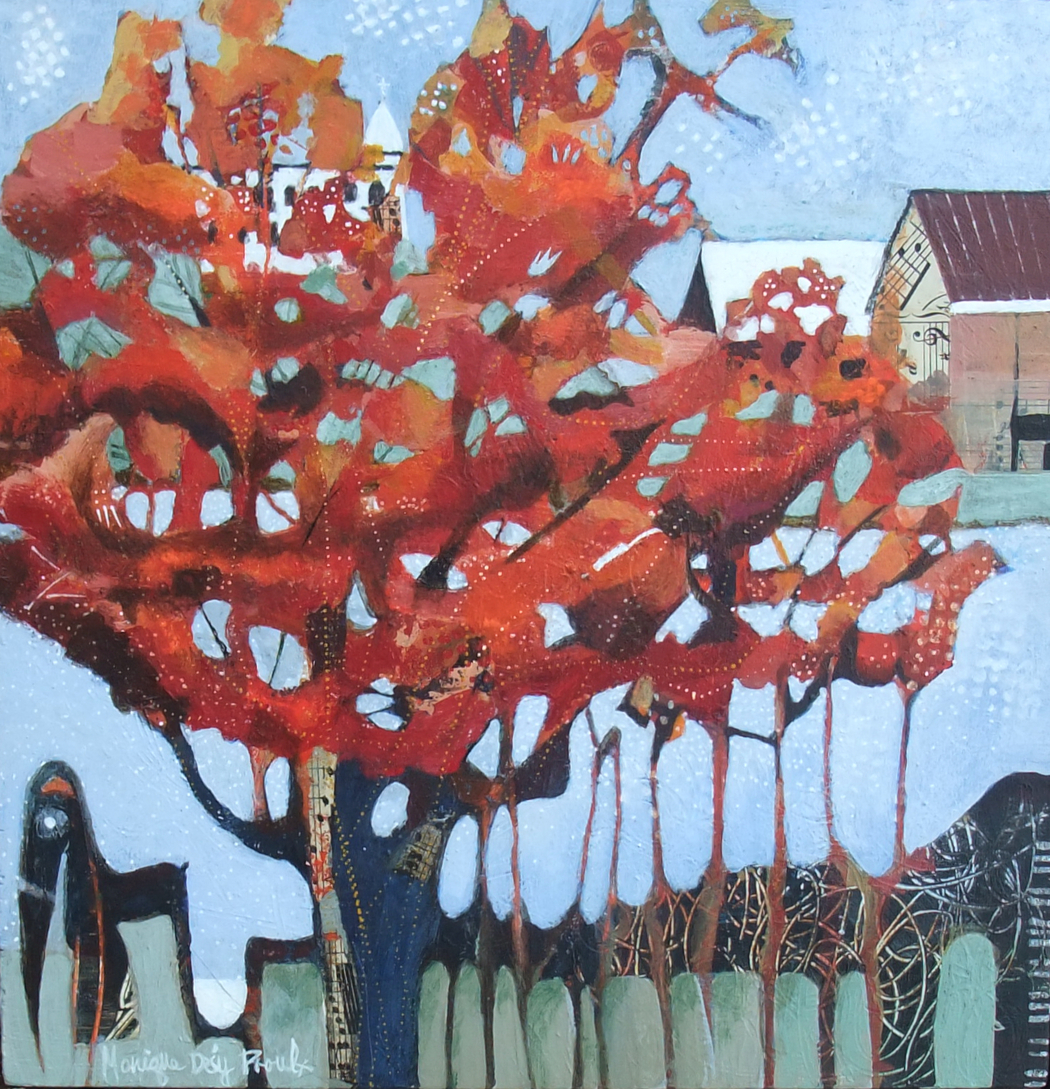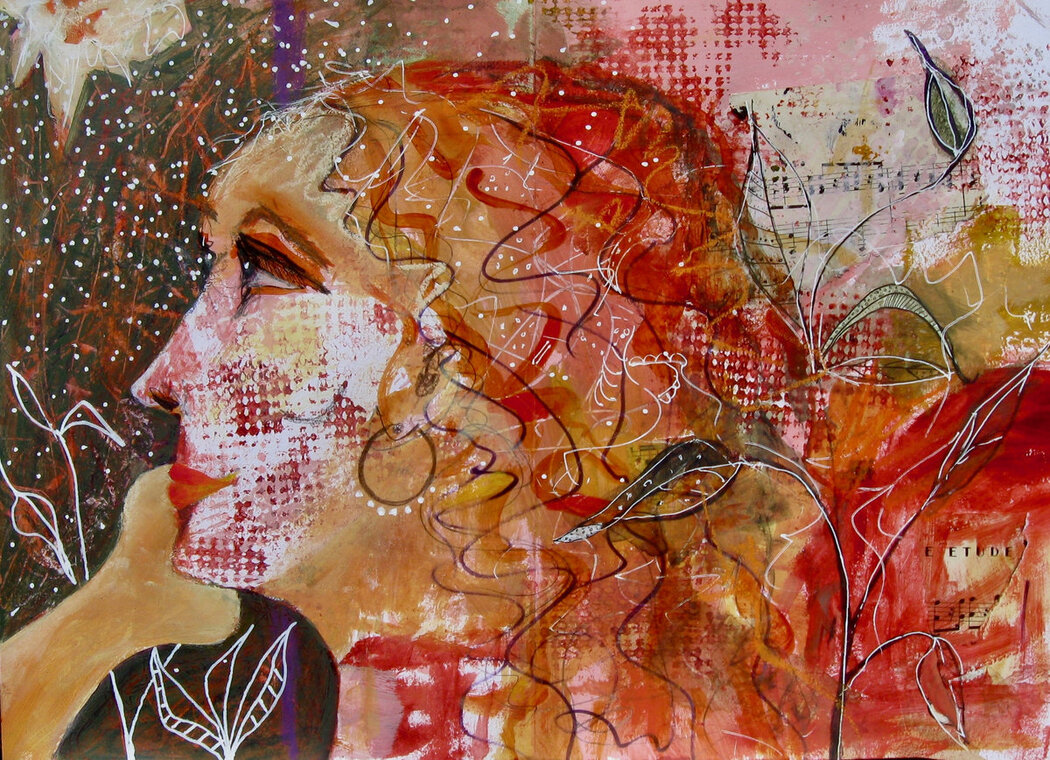Monique D Proulx
I was born in Quebec in the 1950s, in the heart of a French-Canadian village, and spent my early childhood in a house across from a church, between a convent and a parish center. A sheltered environment, where I began to learn the piano at an early age, and to look at French and Belgian comics, which my mother was fond of and whose aesthetic I have always loved, and retained. I then moved to Quebec City, where I studied music at university, and then to Montreal, where I worked as a copywriter in communications and publishing. For several years now, I have settled in the countryside, on the banks of the Richelieu River, in an old henhouse that serves as a refuge for composing, painting and writing. My art in three words? Colorful, poetic, exuberant.
Website | Instagram

Your artistic journey is quite unique, merging both music and painting. How do these two creative outlets influence each other in your work?
These two creative outlets are two parallel ways of expressing what I feel and who I am! And they are so similar in many ways… A lot of musical terms refer to the visual world: tones, harmonies, lines, ascending or descending. In fact, a melody is a line, a succession of notes. That’s the equivalent of the subject in a painting. As for rhythm: it’s movement and it creates texture, like a gesture on the keyboard of a piano determines the sound quality. Color also shares the table with music! Color is vibration, just like sounds. It is not surprising that when painters began to focus on color, painting quickly became abstract, as music inherently is. Even the color wheel, that we use to learn the law of colors, is almost identical to the cycle of fifths, which is the basis of harmony in tonal language. All this is integrated within me. I see colors as sounds that react to each other, with hardness or softness, consonance or dissonance… There are scales in music and scales in color!
We can also listen to sounds for themselves, paying attention to their material quality and ignoring the melody, just as when we contemplate the textures of a canvas without worrying about the subject. I am nourished by this interplay of realities and the resulting emotions. And I love so much these two types of experience, these two modes of expression, that I can’t do without either! Often, people look at my paintings and find them musical. And conversely, how many times have I been told that my music evokes images? Probably that unconsciously, I use music to paint and my visual imagination to compose! 😉
You mentioned that you often integrate old musical scores into your paintings. Can you share more about the process and how you choose which scores to incorporate?
I come from a family of musicians and I inherited a collection of old scores that belonged to my grandfather, my aunts, my mother… The sheets are yellowed, and they are often pieces I don’t want to play, but for which I love the writing, the paper, the alignment of the notes and even the titles or nuance marks. These are cultural and visual artifacts that create for me a special connection with the work in progress and my personal history. So, when I start a painting, I often glue samples of these scores onto the canvas, choosing them somewhat at random, depending on the shapes I want to obtain. I tear them to shreds, trying to leave aside their musical meaning and retain only their graphic aspect. I cover them with transparent medium, so that the paper doesn’t stain and remains visible as long as possible. And then I paint without worrying too much about them. Sometimes they disappear under the various layers of paint, sometimes they remain and I integrate them into the composition, and sometimes I place them specifically to obtain a whitish or greyish stain. This presence of music in my paintings makes me smile, like a funny secret. It brings me joy, a sense of coherence between my work and my life.

The pandemic inspired many artists to explore new avenues. How did the online courses you took during this time impact your artistic style and approach?
Like many others, I took online courses during the confinements. And the most memorable was with the Californian painter Nicolas Wilton, whose work and approach I really like. It transformed me. Firstly, his teaching gave me an extraordinary amount of knowledge about composition, values, textures, processes and product-related techniques. Secondly, I’ve gained freedom, as his approach advocates first and foremost having fun, identifying the areas you prefer, reiterating them, and thus finding your own unique and singular voice. It’s a wonderful way to get to know yourself. I’ve also come to realize that a painting acquires depth when you take risks, for example by completely covering certain parts of the canvas — sometimes even the ones you like best. It’s a question of not getting too quickly attached to what we do, in order to go beyond the limits we are inclined to give ourselves, and to bring life into the work. During this playing stage, I scratch, sand, add, remove, stick, use diverse objects to leave traces on the support. Often, this reveals images that I would never have created if I had decided everything in advance. Now, when I start a painting, I have no idea where things are going to go. It’s almost a work of the unconscious! I choose some colors that I like, I make spots and blobs, then react to these by establishing contrasts of shapes, textures and hues. Little by little, something emerges from this operation focused on the pure pleasure of covering a surface and watching it transform, as children do. It then remains to carry out a sort of cleaning up the mess, or “curate” it, removing what’s excess, adding what’s missing and highlighting the parts that give meaning to the composition. In this stage, I search to express the spirit of synthesis that characterizes me, while retaining spontaneity. It’s a constant dance between reason and intuition.
In this way, I’ve produced several paintings that astonished me. I don’t even know how I made them! But I know that while working, a song would pop into my head. The titles testify to this, and I like the idea of combining a pictorial work with a musical one. The painting becomes a means of materializing the poetry that inhabits me, with all those tunes running through my mind, and all these images and colors that fill my head. The adventure is sometimes scary, but always exciting. It takes me on paths full of surprises where I want to move forward, in order to create a work that is increasingly personal, increasingly free, and — above all — increasingly fun!

Your paintings are described as not imitating nature, but rather reproducing the feeling it gives you. Can you elaborate on how you translate these feelings into your visual art?
What drives me to paint is the wonder I feel in front of nature and life, but I do not seek to reproduce reality. I have neither the taste nor the means. I seek rather to show the structure of forms, the brilliance of colors and the magic of light. And thus manage to offer others my own glasses. The result is a style that is both schematic and nuanced. I want you to see the structure of a subject at a glance, but upon closer inspection you discover a world of textures and details. I am on the border between figurative art and abstraction. Sometimes I evoke into my paintings a very small human presence to give the measure of things. It can be a boat, a roof, a silhouette or… a musical sheet!
Living in an old henhouse that serves as a showcase for your creations is quite poetic. How does your living environment influence your creative process?
I bought this building at a lower cost because the place didn’t look like much, and there was a lot to do. But it allowed me to need less money to live. I was finally able to devote myself to my personal projects, as I had dreamed of. When I arrived, I set about writing a book on the importance of music in human development. I’d had this project in mind for several years. And it’s like a pregnancy, I had to give birth! The book was published in 2015 in Montreal, Quebec, and it is called “Why Music?” Since my house is a sort of old barn, I turned it into a loft, where all the functions are combined: living room, dining room, kitchen, office and piano. As for my workshop, I’ve installed it in a part of the building that was once used as a grain store! I can leave my brushes and canvases lying around. The walls, here, have seen thousands of chickens lay thousands of eggs, and I have the feeling that something has remained: a mission, a vocation. This is a place for creation. An egg is a simple little thing, but beautiful, perfect, and full of promises. It’s a project in itself. So, I think that I’m living in a place made to lay spiritual eggs: paintings, music, books. In the early years, I worked hard to create a garden where there was only asphalt! It was like sculpting a living place. I planted hundreds of trees, shrubs and flowers. I’ve set up little nooks all over the grounds, where I go depending on the season, the sunshine and the time of day. What’s more, this exceptional building sits on the banks of a majestic river where I have my rowboat and whose view enchants me. I want to paint all that! It’s a magical place, made for creating magical pieces. I try to pay tribute to it by using it wisely!

You seek to unite poetry and reason, structure and fantasy in your work. How do you balance these elements while maintaining your artistic voice?
I think it’s precisely these oppositions that underpin my artistic voice. It’s the constant search for a balance between reason and feeling, instinct and mind, spirit and matter, dream and reality. I believe that these multiple back-and-forth movements, sometimes harrowing and agonizing, give rise to my style, which has something both childish and mature, joyful and sad, down-to-earth and dreamy! I start with the concrete by getting my hands dirty, and then I bring in my critical thinking.
I do the same with music. I improvise freely on the piano until I notice certain musical ideas that come back and stick in my head. Then it’s time to pick up a pencil and write down these ideas. It’s also time for logic, as in a chess game: you move a piece, or a note, and that leads to another move, another note, and a new dynamic. These twists and turns, and all the choices I make as I go along develop my language.
What do you hope viewers take away from your paintings, especially those that include musical elements?
The first person I want to touch is myself. I want my painting to bring me a vision of the world where order, beauty and joy exist. It’s also what I want people to see. I would like them to feel a hidden story, with a whimsical and dreamlike atmosphere. To guess the mysterious link that is woven between different modes of expression, different languages, different levels of reality, different aspects of me and themselves. The roof of a house made of sheet music is first and foremost a texture and a design, but it can also be a sign, an allusion to what’s going on inside this house, where the piano is being played, perhaps? A piece of sheet music next to a bird could mean that the bird is singing… The door is open to the imagination, even if my primary intention is more formal than anything else. Above all, I love the graphics of these scores, but you can’t help seeing symbols in them too. And I assume all these dimensions linked to my little yellowed pieces of paper! What I’d like viewers to take away from my paintings? A poetic, moving and sparkling atmosphere…


Leave a Reply